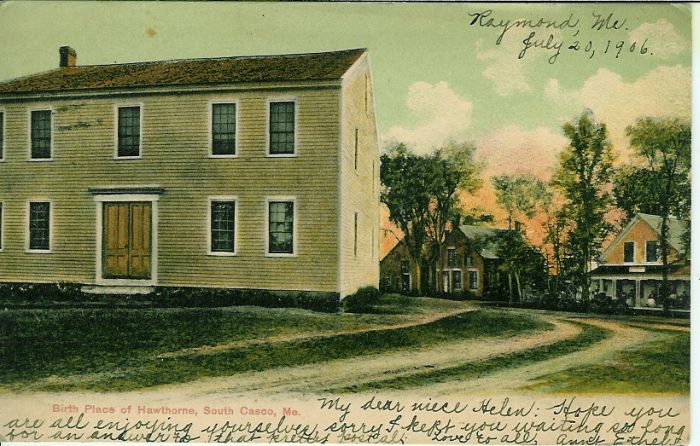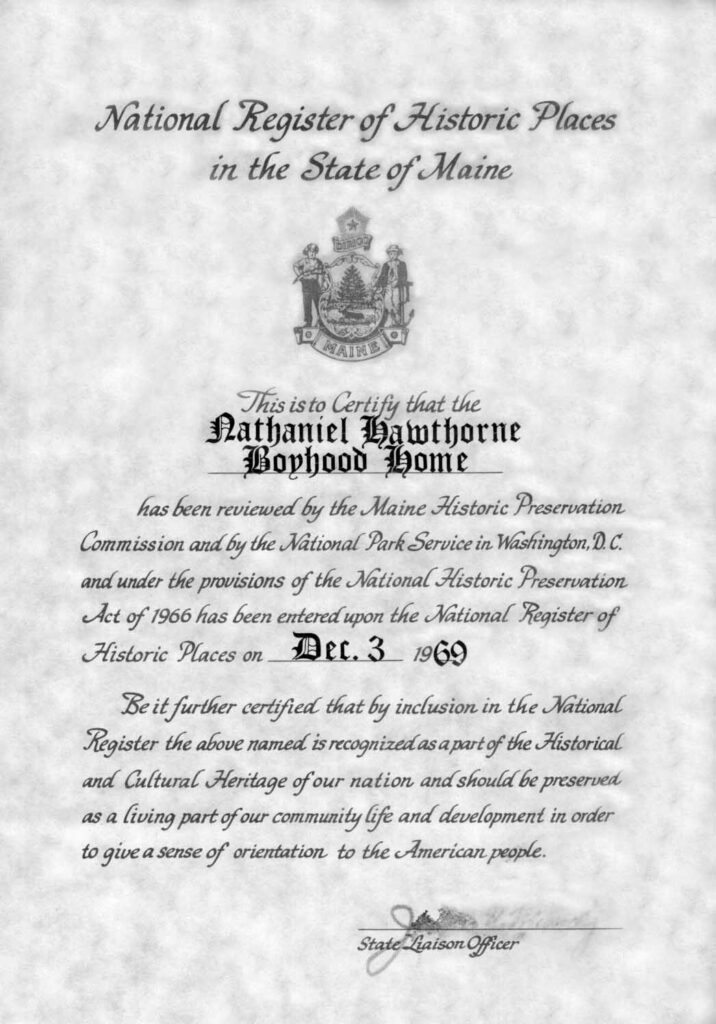Note: This brief history of the Hawthorne House and Association has been in our files for some years, but it is not clear who wrote it. It appears one of our members compiled it using a number of other sources, perhaps in the mid-1980’s.
NATHANIEL HAWTHORNE’S BOYHOOD HOME 1812-1825
 This building in South Casco, Maine, in the township of Raymond, was Nathaniel Hawthorne’s boyhood home where he lived with his mother and his two sisters.
This building in South Casco, Maine, in the township of Raymond, was Nathaniel Hawthorne’s boyhood home where he lived with his mother and his two sisters.
Hawthorne was nine years old when he arrived, and he remained here until it was necessary for him to go elsewhere for schooling. Even in these latter years he always returned to South Caso during his holiday periods and summer vacations.
Hawthorne led a carefree, happy life in South Casco, and undoubtedly these formative years influenced his later life, especially his writing. His memories were agreeable ones, for much later, only a year before his death in 1864, he wrote to a friend, “I lived in Maine like a bird of the air, so perfect was the freedom I enjoyed. But it was there I first got my cursed habit of solitude.” In summer Hawthorne roamed the woods with his gun. In winter he skated on the ice on nearby Sebago Lake. However, his favorite spot was a large flat rock at the head of Dingley Brook [click to see photo] where it flows from Thomas Pond. Here he fished and read, enjoying the solitude of the place.

At the suggestion of his uncle, Richard Manning, Nathaniel kept a boyish diary. This journal seems to have laid the basis of his lifelong habit of keeping notebooks. In it were made many entries, which clearly show his keenness of observation, both of people and scenery, his sense of humor and his shrewdness. Here are a few:
“Swapped pocket knives with Robinson Cook yesterday. Jacob Dingley says he cheated me, but I think not, for I cut a fishing-pole this morning and did it well; besides he is a Quaker and they never cheat.”
“This morning the bucket got off the chain and dropped back into the well. I wanted to go down on the stones and get it. Mother would not consent for fear the well might cave in, but hired Samuel Shaw to go down. In the goodness of her heart she thought the son of old Mrs. Shaw not quite so good as the son of the Widow Hawthorne.”
“We could see the White Hills to the northwest, though Mr. Little said they were eighty miles away; and grand old Rattlesnake to the northeast, in its immense jacket of green oak, looked more inviting than I had ever seen it; while Frye’s Island, with its close growth of great trees growing to the very edge of the water, looked like a monstrous green raft, floating to the south-eastward. Whichever way the eye turned, something charming appeared.”
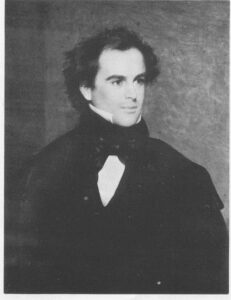
Nathaniel was born on July 4, 1804, the second of three children of Nathaniel Hathorne and Elizabeth Clark Manning. His father, a descendant of William Hathorne who came to America with John Winthrop in 1630, was a sea captain sailing out of Salem, Massachusetts. (Nathaniel, at the time he began to publish, changed the spelling of his surname by the insertion of “w”. His two sisters also adopted this alteration.)
Nathaniel’s father died of yellow fever in Surinam in South America in 1808. His mother was left without resources, and her brother, Robert, an eminent horticulturist, undertook to provide for her. She moved with her young family to the Manning homestead in Salem, where Nathaniel soon got at the many books in the house. There began his love for literature. Oppressed by her great sorrow, Mrs.Hathorne shut herself away from all society except her near relatives. In an effort to divert her attention from herself, her brother Richard, already settled in South Casco-Raymond, offered to build her a house in this Maine wilderness.

The house must have been elegant for its day because its interior was identical with the house Richard had built for himself two years before. Richard had arrived in South Casco twelve years earlier, and had become a prominent resident of the community. He had opened a blacksmith shop and a store where Dingley Brook flows under the old stage road. Eventually he became the proprietor of 12,000 acres of land on the shores of Sebago Lake and ran the stage coach from Raymond to Harrison.
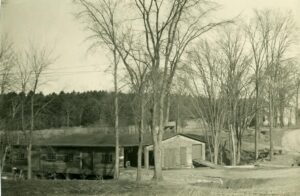
In keeping with his position he constructed his mansion – the finest home in the region. His neighbors called it “Manning’s Folly” because of its immense cost. It still stands, several hundred yards to the west on Raymond Cape Road, across Dingley Brook. Like the Hawthorne House, it is a large square two story structure with massive chimneys and eight fireplaces, one for each of the four rooms on each floor. The interior still has some of the original wall paper and imported Belgian glass.
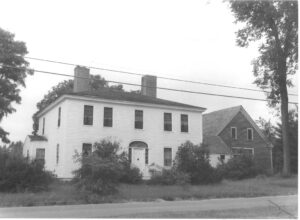
Hawthorne had wanted to follow his father to sea, but because his mother and uncles took note of his gift of intelligence, they decided to send him to college. In preparation, he returned to Salem in 1819 to continue his schooling. Finally, in the fall of 1821, he entered Bowdoin College in Brunswick, Maine. Here he made many lifelong friendships, among them Calvin Stowe (to whom the author of “Uncle Tom’s Cabin” was later married), Henry Wadsworth Longfellow (a classmate), and Franklin Pierce (later to be elected President of the United States). Hawthorne graduated from Bowdoin in 1825, and settled down in Salem where he began his literary career. Any later stays at the South Casco home, if there were any, are not recorded in his writings.
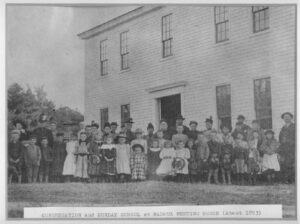
After Nathaniel graduated from college, his mother also returned to Salem to live in her former home. Soon, the venerable old home in South Casco fell into disrepute and decay. For a time it became a stopping place for stage coaches, and was known as Colonel Scribner’s Stage Coach Tavern. Later its tall chimneys were removed and the floor between the two stories taken out to make it into a place of worship for the Radoux Union Meeting Parish. The deed of purchase by the parish took place in 1877 for a payment of $400, and the building became known as the Radoux Union Meeting House.
As new churches were built in nearby communities, the house again fell into disuse and disrepair. Finally, in July 1922, it was given by court order to the recently formed Hawthorne Community Association, its present owner. Interest in the building was only lukewarm, and funds for its repair and upkeep were hard for the association to come by. The depression years of the early 1930’s and World War II caused further delays in rehabilitation. Finally in the 1950’s and especially the 1960’s, community interest was generated and, as a result of local contributions, the building was made into a meeting place for all the community. In addition to the Hawthorne Community Association’s own efforts, assistance has been given by the Hawthorne Garden Club, especially in landscaping the grounds.
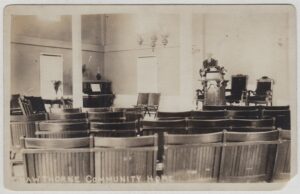
Little remains of the interior of the house as Nathaniel Hawthorne knew it. To best serve the local community interest during the past hundred or more years, it has been used primarily as a meeting place, and no effort has been made to reconstruct it as Richard Manning originally built it, if indeed this could now be done at all. In one corner is an original staircase, and most of the window sashes, some with Manning’s Belgian glass, still remain. Visitors to the Hawthorne House should best attribute to it a nurturing of the seeds of genius that later made him one of America’s most famous writers.
In 1969 the house was placed on the National Register of Historic Places.
